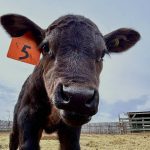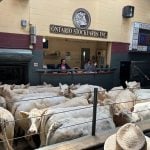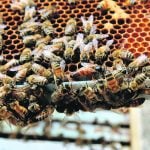Trichomoniasis, abbreviated “trich” and pronounced “trick,” is a highly contagious venereal disease that can result in large numbers of open cows. While it is certainly not a new disease threat, the prevalence has increased dramatically in recent years across the northern tier of the U.S. and gradually edged its way onto ranches in Canada. Venereal diseases in most domestic animals have one thing in common. In males the effects are limited to that of asymptomatic carriers, whereas the negative clinical effects occur in the females.
Trich is caused by the protozoan parasite Tritrichomonas foetus, which lives in the cow’s reproductive tract and on the surface of the bull’s penis. This organism has a close cousin, Tritrichomonas intestinalis, which lives in the intestinal tract and causes no problems other than occasionally interfering with diagnostic tests. Immunity against T. foetus is short lived and cows often become reinfected if exposed to infected bulls.
Read Also

Body condition, nutrition and vaccination for brood cows
One of the remarkable events of the past century related to ranching has been the genetic evolution of brood cows….
Trich control programs are built on two basic prescripts: first, trichomoniasis needs to be a reportable disease, and second, a clear understanding that Trichomoniasis foetus walks into herds via infected bulls, cows and heifers.
The Texas program is established around five principles:
- Bulls entering the state must be officially and permanently identified.
- Breeder certification that young bulls are “virgin” (24 months or younger and never commingled with female cattle).
- Non-virgin breeding bulls and bulls older than 24 months have one negative real-time PCR test, or three consecutive negative culture tests not less than seven days apart within 60 days of entering the state.
- Bulls are accompanied by an official certificate of veterinary inspection.
- Positive bulls are slaughtered.
Other states like North Dakota prohibit the sale of open cows back into breeding herds.
- More from the Canadian Cattlemen: Breeding tips
Good diagnostic tests are available for trich. Tests based on culture require bulls to be tested three times, one week apart, with no breeding activity between tests. In the last few years, diagnostic laboratories have moved to polymerase chain reaction (PCR) assays for detecting trichomoniasis. While PCR tests are very sensitive and detect trich in low numbers, they lack specificity, meaning they can mistakenly identify other organisms that share similar genetic codes with T. foetus. Positive PCRs require verification. The highly sensitive nature of real-time PCR test means pooled samples from several bulls can be screened at one time making testing for trichomoniasis more affordable and feasible during routine breeding soundness examinations. Work at the Western College of Veterinary Medicine in 2013 demonstrated pooled sampling for trichomoniasis testing can be an effective screening tool.
Trichomoniasis can devastate conception rates and profitability. Risk factors include:
- Bulls three years and older are often the primary carriers.
- Cow commingling, adding new untested bulls and retaining open cows are key risk factors.
- Cows infected with T. foetus have calving intervals exceeding 90 days.
- Higher infection rates increase the loss. In trials when bull infection rates increased from 20 to 40 per cent, calf crop losses increased from 14 to 50 per cent compared to uninfected herds.
- Trichomoniasis is insidious and often goes undetected, spread by non-clinical carrier bulls with only occasional signs of infertility in females such as gradual lengthening of the calving interval.
Once it is diagnosed some management practices that need to be considered in designing control programs include:
- Annual testing of bulls and culling the positives prior to breeding season.
- Good fencing to prevent entry of infected animals — both male and female.
- Avoid communal grazing of cattle.
- Purchase only virgin bulls or heifers as replacements. Use of virgin bulls less than three years of age also decreases the probability of a permanent carrier state.
- Keep the average age of herd bulls as young as possible.
- Because this disease is acquired through venereal contact, preferentially use animals that have had no known previous sexual contact.
- Breed and pasture purchased cows and heifers separately — at least through to the next breeding season.
- Reduce the breeding season to 90 to 120 days and perform a pregnancy exam 45 to 60 days thereafter. A long breeding season masks productivity losses due to T. foetus.
- Control other diseases that affect reproduction like campylobacter, BVD and leptospirosis through vaccination.
- Know the disease status of herds from which bulls are purchased and buy only test-negative herd sires.
- Breed the same bulls to the same groups of cattle from one breeding season to the next.
- Cull open cows or place them in a high-risk herd to reduce the spread to susceptible cows. Serious consideration should be given to culling open and late-calving cows as they run the risk of being infected, or may be carriers.
- Avoid buying open and short-bred cows (less than 120 days).
- Create high- and low-risk herds. Virgin heifers and cows unlikely to have been exposed to T. foetus would be classified as low risk. Do not add cattle to low-risk groups until you can verify their disease-free status.
- Isolate any cow that aborts or has a uterine discharge and culture her for the presence of trich. If she is not culled, she should be placed in the high-risk herd and given sexual rest.
- Artificial insemination reduces the chance of disease transmission.
In the face of a trich problem, some veterinarians suggest it makes sense to test bulls before you turn them into the breeding field, then repeat the tests when breeding season is over. That will give you the status of both the bulls and cows. If the bulls are negative, there is a high probability that the cow herd is also negative.
Dr. Ron Clarke prepares this column on behalf of the Western Canadian Association of Bovine Practitioners. Suggestions for future articles can be sent to Canadian Cattlemen or WCABP.
















